|
Class 101 |
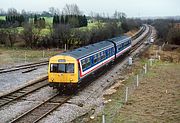 |
With the North Oxford Golf Course in the background, L200 (51215 & 54081) passes Water Eaton (Banbury Road) on 23 February 1991 with the 2C20 07:40 Reading to Bicester Town Network SouthEast service. The unit has just passed over the point that allowed access to the stone terminal, situated on the other side of the bridge on which I was standing. Note the long headshunt in the background. Approximately adjacent to the end of the headshunt is the site of Oxford Road Junction, where a former LNWR line diverged to the right, crossed the Oxford to Banbury line, and joined the Cotswold Line near Yarnton Junction. Even in BR days this was known as the LMS Loop. It closed in 1965. |
|
 |
There would probably be a lot more than just one passenger at Heyford for a morning train to Oxford and Reading nowadays, but in the early 1990s passenger numbers were still fairly low. L200 (51215 & 54081) calls at the station on 17 May 1991 with the 2C23 09:15 Banbury to Reading Network SouthEast service. |
|
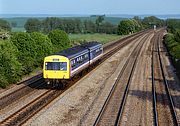 |
L200 (54081 & 51215) looks commendably clean as it rattles along the down relief line at South Moreton on 21 May 1991 with the 2C68 17:57 Reading to Didcot Network SouthEast service. This was once an excellent location for photography in both directions (at least on the relief lines), but the rebuilding of the bridge (for a second time) has made it difficult due to very high parapets. |
|
 |
Metro Cammell meets Gloucester Railway Carriage & Wagon Company. Two Network SouthEast stopping trains pass each other in the deep cutting near Cholsey on 16 August 1991. L200 (54081 & 51215) approaches with the 2C56 16:30 Reading to Didcot, while L595 (51086, 59430 & 51074) heads in the opposite direction with the 2C51 15:55 Bicester Town to Reading. |
|
 |
L200 (51215 & 54081) approaches Goring on 28 August 1991 with the 2C51 15:55 Bicester Town to Reading Network SouthEast service. Around this time the two car Class 101s were generally used on the Bicester trains, with the majority of the other local services through the Thames Valley worked by three car Pressed Steel Class 117s. |
|
 |
201 (54070 & 51212) passes Tackley on 23 April 1988 with the 2C55 17:23 Banbury to Oxford Network SouthEast service. The unit acquired the normal L prefix (for Reading allocated sets) the following year. The glancing light is showing up some less than perfect welding on the front end! |
|
 |
L201 (54070 & 51212) leaves Kings Sutton station on 17 March 1990 with the 2H41 14:50 Banbury to Oxford Network SouthEast service. I think the GB sticker is being a bit optimistic! Note how in those days there was no barrier between the small car park and the site of the former sidings on the right. This was before the days of everything being fenced off with palisade fencing. |
|
 |
Viewed from the Walton Well Road bridge, and with the Aristotle Lane footbridge in the background, L201 (54070 & 51212) approaches Oxford on 7 April 1990 with the 2H19 09:22 Bicester Town to Oxford Network SouthEast service. The driver obviously forgot to change the destination blind at Bicester! |
|
 |
Several Class 101 twin sets received Network SouthEast livery in the late 1980s. On 4 May 1990, L201 (51212 & 54070) is pictured passing Wolvercote Common with the late running 17:56 Oxford to Banbury service. This is the site of Wolvercote Siding, and the footpath crossing used to be an excellent place to observe northbound trains in the evening. Unfortunately this is another location that is no longer possible, as the footpath has been closed. |
|
 |
Cambridge depot's set 20 (54372 & 51443) passes Great Paxton on 20 September 1986 with the 07:37 Hitchin to Peterborough service. The extremely early time of day explains how it is possible to have the sun on the front of a northbound train on the East Coast Mainline. The Western Region did not posses many Class 101 units until the late 1980s, and indeed this shows a unit that would soon be moving to the Western. However, it would not remain together as a single unit, the front vehicle (54372) would form part of unit L202, whilst the rear car (51443) would find itself in L205. The original 6x7 slide of this image unfortunately looks nothing like this, as it is one of the few (luckily) pictures that I took on Agfachrome 200RS. It has now turned completely purple! Luckily Photoshop has once again come to the rescue. |
|
 |
Good patronage for L202 (51225 & 54372) as it arrives at Heyford on 17 August 1988 with the 2C15 07:58 Banbury to Oxford Network SouthEast service. This is Heyford station in intermediate form, with the old station building gone and with a new platform surface (at least opposite where the units stop), but before the replacement of the GWR footbridge. |
|
 |
A rural scene that is now nearer to the days of steam than to the modern railway. Not only have Metro Cammell DMUs long since disappeared from the national network, but that other hang over from the 1960s, the lineside domestic coal yard is also very nearly a thing of the past. On 17 August 1988 the yard on the site of Bletchingdon station still has a good selection of various types of coal on offer. L202 (51225 & 54372) passes by with the 2C55 17:12 Banbury to Oxford Network SouthEast service. This was guaranteed to be a Class 101 unit, and in fact the working timetable even stated: 'Special timings - worked by Class 101 DMU'. |
|
 |
L202 (54372 & 51225) passes Wolvercote on 7 September 1988 with the late running 2M60 17:50 Oxford to Banbury Network SouthEast service. I'm not quite sure of the point of the handwritten set number on the front, or what the mark underneath it has obliterated. This picture is taken from the long since closed footpath crossing that gave access to Port Meadow. |
|
 |
A frosty morning at Walton Well Road, Oxford, on 5 November 1988, as L202 (51225 & 54372) heads south with the 2V70 07:58 Banbury to Oxford local service, no doubt having picked up a few Saturday shoppers from Kings Sutton, Heyford and Tackley. The typical early morning autumnal fog is only just clearing, bringing Aristotle Lane footbridge in the background into view. |
|
 |
L202 (54372 & 51225) has just joined the mainline at Oxford North Junction on 19 August 1989, after traversing the single track line from Bicester with the 2H09 07:58 Bicester Town to Oxford Network SouthEast service. |
|
 |
After an almost completely cloudy day, with intermittent rain, the sun finally beaks through on the evening on 4 July 1990. L202 (54372 & 51225) passes Hinksey Yard with the 2C64 16:42 Didcot Parkway to Oxford Network SouthEast service. |
|
 |
L202 (54372 & 51225) passes Wolvercote on 23 July 1990 with the late running 2C60 17:05 Reading to Banbury Network SouthEast service. This is definitely not a location to visit now, as the rebuilt A34 Oxford bypass bridge would not be a safe place to stand. It was bad enough in the 1990s! |
|
 |
Now unfortunately demolished, this distinctive cottage used to stand next to the crossing at the south end of Tackley station (between Oxford and Banbury). L202 (54372 & 51225) approaches with the 2C70 19:23 Oxford to Banbury Network SouthEast service on 23 July 1990. L202 has not faired any better than the building, being cut up at Gwent Demolition, Margam in 1994. |
|
 |
A pair of trains occupying platform 1 at Oxford on 24 July 1990. L202 (54372 & 51225) cautiously approaches the rear of the 1V97 15:18 Manchester Piccadilly to Paddington InterCity service, which had arrived at the station 25 minutes late behind 47841 The Institution of Mechanical Engineers. L202 was working the 2C63 18:18 Bicester Town to Reading Network SouthEast service, and was now running five minutes late because of the 47, hence the doubling up at the platform. 47052 can be seen in the bay platform. |
|
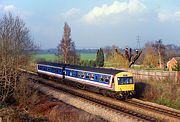 |
L202 (51225 & 54372) arrives at Radley on 14 March 1991 with the 2C49 15:15 Banbury to Reading Network SouthEast service. Whilst most Class 101s operated in only semi-permanent sets, those on the Western Region were kept in more or less permanent formations, and as such were given set numbers. However, it seems that L202 has received a front end repaint, as DMBS 51225 is not carrying any front end identification in this view. |
|
 |
L202 (54372 & 51225) leaves a rather deserted looking Oxford station on 28 June 1991 with the late running 2C21 09:02 Bicester Town to Reading Network SouthEast service. The sidings in the foreground have clearly not seen any traffic for quite a while! |
|
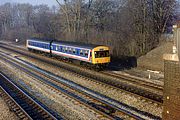 |
L202 (51225 & 54372) passes South Moreton (Didcot East) on 11 December 1991 with the 2C31 11:15 Banbury to Reading Network SouthEast service. L202, like several Western Region Class 101 sets at the time, only had the normally standard chrome window surrounds on the DMBS vehicle. |
|
 |
High summer at Kings Sutton, and the farmer has started to cut the grass for silage. L204 (51220 & 54371) accelerates away from Kings Sutton station (hidden by the bushes) on 20 June 1989 with the 2H70 19:24 Oxford to Banbury Network SouthEast service. This was running ten minutes late, something which was far less common then than it is three decades later! |
|
 |
Thousands of railways photographs must have been taken over the years from the rather flimsy footbridge that crossed the north end of Hinksey Yard, near Oxford. I have taken several hundred myself! For a change here is a view of a train passing underneath the bridge. L204 (54371 & 51220) works the 2C23 11:00 Oxford to Didcot Parkway Network SouthEast service on 23 July 1989. |
|
 |
L204 (51220 & 54371) & Class 121 55025 (L125) pass South Moreton in whiteout conditions on 9 February 1991 with what should be the 2C32 10:30 Reading to Bicester Town Network SouthEast service. However, perhaps on this occasion the Oxford destination being displayed is not a mistake (as was often the case), but the result of a revised service due to the severe weather conditions. |
|
 |
It may be late in the evening, but the station lights at Radley are still a little premature in coming on, as L204 (54371 & 51220) passes through the station on 24 April 1991 with the 2C63 18:18 Bicester Town to Reading Network SouthEast service. Note the new fence on the right, which had just blocked off vehicular access to the up platform. |
|
 |
A Metro Cammell meeting at Cholsey on 3 July 1991. L204 (51220 & 54371) accelerates away from the station with the 2C68 17:57 Reading to Didcot Parkway Network SouthEast service, while in the background the 2C59 17:15 Banbury to Reading train calls at the station. |
|
 |
L204 (54371 & 51220) passes Hinksey Yard on 5 July 1991 with the 2C13 08:03 Oxford to Reading Network SouthEast service. Sequentially numbered L205 (54385 & 51367) followed just ten minutes later with the 2C15 07:40 Banbury to Reading train. Normally that would make for identical pictures, but L205 had just been reformed into a hybrid Class 101/117 set. |
|
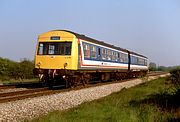 |
L205 (54385 & 51443) passes Wolvercote on 4 May 1989 with the 2H60 17:50 Oxford to Banbury Network SouthEast service. A note in the working timetable indicated that this train was to be worked by a Class 101 DMU to 'special timings'. |
|
 |
L205 (51443 & 54385) is pictured near Charlton-on-Otmoor on the Bicester to Oxford line on 31 March 1990 with the 11:48 Bicester Town to Oxford Network SouthEast service. The tall white structure visible in the background is in connection with the construction of the M40 motorway. The bridge crossing this line would shortly be built just where the track disappears from view. L205 was withdrawn two years later and cut up at MC Metal Processing, Glasgow in 1993. |
|
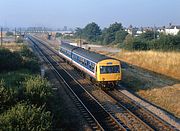 |
To emphasise how much passenger growth there has been in the Thames Valley in recent years, here is a view of Radley station on 21 July 1990 with just a solitary Mini parked in the car park! L205 (51443 & 54385) pulls away with the 06:30 Reading to Bicester Town Network SouthEast service. Note the passengers on the up platform awaiting the arrival of the 07:15 Oxford to Paddington service, the first train of the day in that direction, unless you count the one just after midnight! |
|
 |
A historic scene, where nothing other than the track is the same today. L205 (54385 & 51443) passes the Banbury Road stone terminal at Water Eaton on 15 September 1990 with the 2C35 11:51 Bicester Town to Oxford Network SouthEast service. This is now the site of Oxford Parkway station, with the stone terminal moved further back along the line. The background has also changed, as a forest of trees now completely hides the then recently realigned A34 from view. The unloaded stone train in the foreground waits to leave behind 56036. |
|
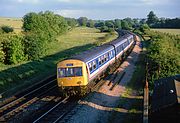 |
For a short period in 1991, Class 117 three car unit L418 had its DMS vehicle (51397) replaced with Class 101 DMBS 51443 from unit L205. With two brake compartments this hybrid unit certainly had plenty of luggage space, especially compared with the Turbo units that replaced it the following year! L418 (51443, 59507 & 51355) is pictured arriving at Heyford on 19 June 1991 with the 2C70 19:26 Oxford to Banbury Network SouthEast service. Close inspection of the original 35mm Fujichrome slide shows the remains of the lead vehicle's former unit number L205, underneath the hastily applied L418. The hedge on the right has grown considerably since this picture was taken, making photography from this spot almost impossible. |
|
 |
Hybrid Class 101/117 set L205 (54385 & 51367) passes Hinksey Yard on 5 July 1991 with the 2C15 07:40 Banbury to Reading Network SouthEast service, coincidentally following right behind L204 (54371 & 51220) with the 2C13 08:03 Oxford to Reading train. |
|
 |
L418 (51443, 59507 & 51355) passes Swanbourne on 13 July 1991 with a Bedford Bletchley Rail User's Association & Oxon & Bucks Rail Action Committee special train from Oxford to Bedford. The train was organised to mark the 140th anniversary of the coming of the railway to Oxford. The long disused Swanbourne station can be seen in the background. Only the lead vehicle of this unit is a Class 101, which explains the L418 set number. 51443 is substituting for DMS 51397 out of the original Class 117 set L418. |
|
 |
Hybrid Class 101/117 set L205 (54385 & 51367) pulls away from Culham station on 15 August 1991 with the 2C61 18:30 Oxford to Reading Network SouthEast service. The Class 101 vehicle is wearing the later darker shade of NSE blue, while the Class 117 coach is in the earlier lighter blue livery. |
|
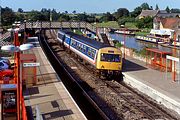 |
L205 arrives at Heyford station on 6 July 1992 with the 2C59 17:15 Banbury to Reading Network SouthEast service. A couple of months earlier, this set had become a Class 101/117 hybrid, after DMBS 51443 had been withdrawn. To replace it, DTCL 54385 had received Class 117 DMBS 51367 from set L429 as its new partner. In addition to the different shade of NSE blue, the aluminium windows frames of the Class 101 immediately contrast with the 117 vehicle. This combination would last for little more than a year, before 54385 was also withdrawn. |
|
 |
Unfortunately I made very few visits to the East Coast Mainline before it was electrified in the 1980s. I particularly regret not visiting this location more often, before it was ruined by the overhead wires. This is the view from New England Bridge, Wennington on 12 December 1985. What a superb location it must have been in the days of the Deltics. The first signs of the end are apparent here, as the new masts have sprung up along the west side of the line. Note how they can be seen curving round to the right in the background, past the isolated Wood Walton church. One of Cambridge depot's twin car sets, 54396 & 51221 rattles along the up relief line with the 12:05 Peterborough to Hitchin 'all stations' service, which in true heritage DMU tradition is showing the wrong destination, in this case Peterborough from where it has just come. This particular unit would become a lot more familiar to me a few years later, as it was transferred to the Western Region, becoming set L207. The bridge in the background is in fact an aqueduct, carrying a small stream across the line. |
|
 |
Cambridge set 07 (51221 & 54396) nears journey's end, as it passes Milton Fen on 4 November 1986 with the 07:20 Birmingham New Street to Cambridge service. Just over a year later this unit would find itself much nearer to my home territory, when it was transferred to Network SouthEast duties in the Thames Valley. |
|
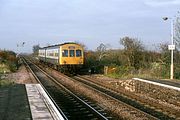 |
Cambridge set 07 (51221 & 54396) approaches Manea station on 4 November 1986 with the 13:13 Peterborough to Cambridge service. Like the vast majority of trains passing this spot, it would not be stopping. Although the formation didn't alter, this become set 52 a few months later. |
|
 |
The sticker on the front says it all really! Passengers board L207 (54396 & 51221) at Islip on 13 May 1989 for the journey to Bicester Town. The train had arrived from Oxford, and was the first to call at the station since 1967. To accommodate the large numbers of locals wanting to sample the new service, the two car unit was strengthened by the addition of three car Class 117 unit L400. |
|
 |
L207 (51221 & 54396) passes Oxford North Junction on 20 July 1990 with the 2C58 17:43 Oxford to Bicester Town Network SouthEast service. It is just starting to weave across from the down main line, in order to gain the branch, with the front bogie of 51221 actually on the point. |
|
 |
L207 (54396 & 51221) leaves Oxford station on 28 June 1991 with the 2C13 08:03 Oxford to Reading Network SouthEast service. A surprise visitor to platform 2 in the background is 56050, working the late running 6A42 04:10 Stoke Gifford to Calvert Avon Binliner. This should have passed through the station over two hours earlier, and was booked to take the centre through line. |
|
 |
L207 (54396 & 51221) passes Hinksey Yard on 29 July 1991 with the 2C45 14:48 Oxford to Reading Network SouthEast 'all stations' service. What is particularly interesting about this picture is that it shows various Oxford landmarks, which have long since been obscured by trees from this location. On the left, partially hidden behind the mast like structure of Oxford Ice Rink, is St Barnabas church in Jericho. To the right of the ice rink is the chimney of Morrells brewery, still clearly in use at the time. The brewery closed in 1998, but the chimney remains. Further to the right is the tower of Oxford Castle, whilst on the extreme right is the tower and spire of Nuffield College (completed in 1960). |
|
 |
A picture that I expect very few other photographer bothered to take, but which has now changed completely. With Islip church visible on the horizon, L207 (51221 & 54396) passes Water Eaton on 17 August 1993 with the 2C61 18:15 Bicester to Oxford (not Reading, as it says in the destination blind!) Network SouthEast service. Two decades later, almost every aspect of this picture is radically different. NSE Class 101s are of course long gone, and the young saplings in the foreground, on the embankment of the then recently opened A34 Gosford bypass have now grown so tall as to completely block out this view. The major change however is the present upgrading of this sleepy backwater into a trunk route, and the building of the new Oxford Parkway station on this site. |
|
 |
Hybrid Class 101/116 unit L210 (54381 & 53083) accelerates away from Radley station on 15 May 1992 with the 2C64 17:21 Reading to Oxford Network SouthEast service. With the introduction of the new Class 165s in full swing, both vehicles forming L210 would be withdrawn just four months later. When this picture was taken, the tall radio mast had just been installed, which was stage one of spoiling this as a photographic location. Stage two was the growth of the roadside trees that completely blocked the view! |
|
 |
L211 (53155 & 54287) crosses the bridge over the River Cherwell at Hampton Gay on 11 July 1989, as it heads north with the 2C70 19:24 Oxford to Banbury Network SouthEast service. This is a hybrid Class 101/121 set, the rear vehicle being one of the Class 121 trailers that usually worked with their Class 121 DMBS classmates. |
|
 |
Next stop Culham. Hybrid Class 101/121 set L211 (53155 & 54287) slows down on the approach to Culham station (just visible in the distance), as it works the 2C61 18:30 Oxford to Reading 'all stations' Network SouthEast service on 10 July 1991. The hangars of the former Royal Naval Air Station Culham dominate the background. |
|
 |
L220 (54405 & 51207) approaches Waterbeach station's staggered platforms in soft early morning sunshine on 14 September 1991 with the 08:20 Cambridge to Ely Network SouthEast service. Classmate L221 (54402 & 51208) can just be seen disappearing into the distance with the 07:27 Kings Lynn to Cambridge train. |
|
 |
L220 (51207 & 54405) crosses North Fen (near Waterbeach) on 14 September 1991 with the 10:37 King's Lynn to Cambridge Network SouthEast service. Class 317 EMUs would take over from the venerable Metro Cammell units the following year, when the newly installed wires seen here were finally switched on. As a result, L220 was withdrawn shortly afterwards, and cut up in 1993. |
|
 |
L221 (54402 & 51208) arrives at Waterbeach station on 14 September 1991 with the 07:27 Kings Lynn to Cambridge Network SouthEast service. Waterbeach station's platforms are staggered either side of Clayhithe Road level crossing (just behind the rear of the train). |
|
 |
Network SouthEast liveried L700 (53296, 59128 & 53207) arrives at Waterbeach with the 08:27 King's Lynn to Cambridge service on 14 September 1991. Waterbeach station has staggered platforms either side of the level crossing. This unit was withdrawn a few months later and quickly scrapped with the set number being reused. |
|
 |
L700 (53296, 59128 & 53207) crosses the flat open landscape of North Fen (near Waterbeach) on 14 September 1991 with the 11:37 King's Lynn to Cambridge Network SouthEast service. The electrification of the route to King's Lynn would be completed the following year, but L700 would not last that long, being withdrawn in December 1991. |
|
 |
I only managed to get a few pictures of refurbished first generation DMUs in their short lived white with blue stripe livery. Any livery with large areas of white is hardly a practical proposition on railway vehicles, and this livery was soon abandoned in favour of the standard blue and grey coach scheme. In gloomy weather conditions, Class 101 Metro Cammell unit B800 (51515, 59549 & 51445) stands at a deserted Kemble station on 26 August 1979 with the 2B16 17:15 Swindon to Cheltenham service. |
|
 |
C801 (51446 & 51517) pulls out of Kemble station on 21 May 1988 with the 2B03 07:35 Swindon to Hereford service. Although the high intensity headlight is not on, it certainly seems that the marker lights are displaying white rather than red lights to the rear, contrary to regulations. Just visible in the background, approaching through the early morning mist, is 47565, which is working the 3A42 07:15 Gloucester to Swindon parcels. |
|
 |
C801 (51446 & 51517) passes Bremell Sidings on 19 June 1988 with the 2B74 15:02 Swindon to Gloucester service. This picture was deliberately taken from this angle to give a good clear view of the oil terminal sidings, which judging by the state of the track, hadn't seen a train for quite a while. The town of Swindon can be seen in the background. |
|
 |
B802 (51521, 59550 & 51449) calls at Kemble station on 1 December 1979 with the late running 2B19 11:10 Worcester Shrub Hill to Swindon service. I have very pictures of DMUs in this short lived mostly white livery. Coincidentally, one of the others also happens to be at Kemble. |
|
 |
C803 (51450 & 51522) passes Bayston Hill on 3 July 1985 with the 05:40 Swansea to Shrewsbury service, nearing the end of its mammoth 3½ hour journey via the Central Wales Line. Already having lost its centre coach (59546), C803 was to survive for another four years before making way for the new generation of Sprinter units. |
|
 |
S803 (51450 & 51522) passes Briton Ferry on 25 March 1987 with the 13:05 Fishguard Harbour to Cardiff Central service. Unfortunately this panoramic view has now been lost due to uncontrolled tree growth. In 1987 is was still possible to see the town of Neath, with Mynydd Marchywel rising up behind it in the background. The track coming in from the left is the exit from Briton Ferry Yard. |
|
 |
S803 (51522 & 51450) passes Baglan on 25 March 1987 with the 16:30 Cardiff Central to Swansea service. Nowadays the equivalent train would be stopping here, as Baglan station (opened in 1996) now occupies this site. |
|
 |
C804 (51452 & 51523) and an unidentified Tyseley allocated Class 116 set pass milepost 97½ at Chalford on 13 July 1985 with the 2A56 08:28 Gloucester to Swindon service. The addition of the Class 116 was presumably to increase capacity in connection with the International Air Tattoo at Fairford. |
|
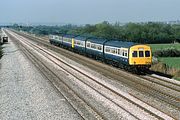 |
C811 (51519, 59548 & 51801) & Class 117 B439 (51390, 59500 & 51348) pass Marshfield on 28 April 1984 with the 09:55 Cardiff Central to Bristol Temple Meads service. By the 1980s virtually all surviving DMU classes employed the Blue Star multiple working system, so despite there still being many different classes, from several different manufacturers, there was no problem in running trains such as this. This degree of standardisation has unfortunately not been totally perpetuated with modern units. For example a Class 158 cannot work in multiple with a Class 165, not that the need would ever arise! |
|
 |
Just ahead of an approaching storm, C811 (51801 & 51519) approaches Purton with the 2A62 10:30 Cheltenham to Swindon service on 20 July 1985. This unit was withdrawn in 1989 and cut up at Mayer Newman at Snailwell the following year. In common with a lot of Western Region units it had already lost its intermediate trailer (59548) by the mid 1980s. |
|
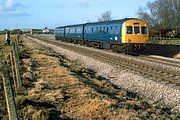 |
B812 (51462, 59530 & 51530) passes Stoke Orchard with the 14:57 Worcester Shrub Hill to Gloucester service on 13 March 1982. Note the plated over square section under the centre windscreen - the site of the former two character route indicator panel. On this unit the destination blind is missing, revealing the three bulbs used for illumination! This location is now spoiled by ubiquitous palisade fencing, which together with much lineside vegetation makes this view impossible now. In the 1980s a young couple could take their son to the lineside to watch the trains go by, with just a simple concrete post and wire fence between them and the line. |
|
 |
C812 (51462, 59530 & 51530) passes the grass covered platforms of Oaksey Halt on 2 April 1983 with the 2C32 16:48 Swindon to Newport (via Gloucester) service. As the line was singled in the late 1960s, there was no need to demolish the disused platforms, and so they remained intact for over three decades, until the redoubling of the line saw them removed in 2013. |
|
 |
C812 (51462, 59530 & 51530) is clearly not going to Chepstow, as it leaves Kemble station on 15 December 1984. It is in fact working the 11:52 Cheltenham to Swindon service. The fine Great Western Railway station survives, but all three vehicles of this DMU have now been recycled into who knows what! |
|
 |
How would you fancy a 128 mile trip in a Class 101 DMU? However, despite Crewe being displayed in the destination blind, this is in fact the 15:40 Cardiff Central to Shrewsbury service, a mere 95 miles of rattling and vibration! Western Region sets C814 (53335, 59123, 53319) & C806 (51808, 51799) pass Ponthir on 4 September 1986. This was before the modern housing development encroached on the scene, although even here the JCB on the left looks ominous. |
|
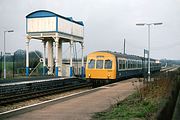 |
C820 (51500, 59093 & 51512) arrives at Kemble station on Sunday 7 March 1982 with the 2B37 15:25 Worcester Shrub Hill to Swindon service. The blue and white colour scheme on the water tower was replaced in the late 1990s by a variation of the Great Western Railway's 'Light Stone' and 'Dark Stone' colours. |
|
 |
C820 (51500, 59093 & 51512) passes Churchdown on 16 June 1983 with the 09:57 Worcester Shrub Hill to Gloucester service. A misty day, with the Cotswold Hills barely visible in the background. This has allowed the picture to be taken from the north side of the line, which would normally be in shadow until very late in the evening. |
|
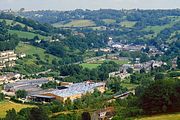 |
Spot the train! This ultimate train in the landscape picture shows C820 (51500, 59093 & 51512) heading up the Stroud Valley at Brimscombe on 21 August 1985 with the 2A72 15:30 Cheltenham Spa to Swindon service. The large industrial buildings in the foreground are on the site of the former Phoenix Iron Works, and the houses on the left are part of Far Thrupp. Brimscombe is in the middle distance, with the Brimscombe & Thrupp football club's ground in the centre of the picture. Obviously there is no way that the DMU could be identified from this distance, but as I had seen it earlier in the day, a quick check of its diagrams in the working timetable has established its identity. |
|
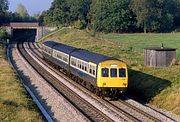 |
C820 (51512, 59093 & 51500) passes Croome on 24 October 1985 with a mystery southbound working. There is nothing in the working timetable to indicate what this is, but my best guess is that it is the 5A72 15:25 Alstone Carriage Siding to Cheltenham Spa ECS, which has for some reason started from Worcester. If Alstone Siding was unavailable for any reason, the 5B29 14:17 Cheltenham Spa to Alstone ECS could have continued on to Worcester, in order to work back later as the 5A72, and then work the 2A72 15:30 Cheltenham Spa to Swindon service. |
|
 |
C820 (51512, 59093 & 51500) takes the 'Golden Valley' route at Standish Junction on 11 October 1986 whilst working the 09:27 Cheltenham to Swindon service. Yet again the driver has forgotten to change the destination blind. I wonder if it says 'Swindon' on the other end? |
|
 |
Up until the early 1990s, there was a virtually unobstructed view of Frampton Mansell Viaduct from the hillside to the south. C820 (51500, 59093 & 51512) crosses the nine arch structure with the 2A54 09:27 Cheltenham Spa to Swindon service on 11 April 1987. Such is the quality of the original 6x7 Ektachrome slide, that not only can both the set and leading vehicle numbers be clearly read, but also the destination blind, which in true unhelpful 1980s style is showing Gloucester! |
|
 |
C820 (51512, 59093 & 51500) takes the Westbury line at Fairwood Junction on 20 April 1988 with the 2V59 08:58 Weymouth to Swindon, a nearly three hour journey of rattling and vibration, calling at all stations! Perhaps that is why on close inspection of the original slide, it appears to be virtually empty. |
|
 |
With the Kennet & Avon Canal in the foreground, C820 (51512, 59093 & 51500) traverses the Avon Valley near Bathampton on 20 April 1988 with the 2V66 14:58 Weymouth to Cardiff Central service. Not only were the Class 33 loco hauled trains on this route in their final weeks when this picture was taken, but these old Class 101s would also soon be replaced by the new Class 155s. |
|
 |
The Cambrian Heritage Railways resident DMU (51512 & 51187) waits at Penygarreg Halt prior to heading back to the line's headquarters at Llynclys on 4 June 2012. Although in working order, 51512 is in severe need of a repaint, especially the roof! In a former life it formed part of the Western Region set C820. Penygarreg Halt opened in 2011 and is situated to the north of the former Cambrian Railways station at Pant. |
|
 |
C821 (51513, 59050, & 51509) arrives at Stonehouse with the 09:30 Cheltenham to Swindon service on 29 October 1983, not that you would know it as the destination blind is missing, revealing three bulbs! This is the former Great Western station at Stonehouse on the Golden Valley line. Originally there was another station on the former LMS line to Gloucester. All three vehicles of set 821 have now been scrapped, 51513 & 59050 at Mayer Newman, Snailwell, and 51509 at Sims Metals, Cardiff. |
|
 |
C821 (51513, 59050, & 51509) rattles away from Cheltenham station (just beyond the bridge in the background) with the 10:30 Cheltenham to Swindon service on 21 August 1985. In common with a number of Western Region Class 101 units, C821 received red buffers beams towards the end of its life. It didn't help though, Sprinterisation was just around the corner! |
|
 |
C822 (51510, 59096 & 51495) approaches Combe on 21 August 1982 with the 2A77 06:29 Great Malvern to Oxford service. Not a very good photo, but this is my only picture of an all over blue liveried Class 101 on the Cotswold Line. Class 101s were not particularly common on the line anyway, and this one is a long way from its Cardiff home. |
|
 |
Unfortunately I have got very few pictures of DMUs in all over blue livery, but this is one of the better ones. C822 (51510, 59096 & 51495) passes Croome on 9 April 1983 with the 2B51 15:06 Worcester Foregate Street to Swindon service. C822 was painted into the then standard blue and grey livery later in the year. |
|
 |
C822 (51495, 59096 & 51510) approaches Cheltenham on 21 August 1985 with the 2B18 09:42 Swindon to Worcester Shrub Hill service. The unit moved further west shortly after this picture was taken, changing its C (Cardiff) prefix for a S (Swansea) one. All three vehicles were withdrawn by 1990, and soon succumbed to the cutter's torch. |
|
 |
C822 (51495, 59096 & 51510) leaves Gloucester on 21 August 1985 with the 2A68 13:30 Cheltenham to Swindon service. The convenient earth bank that this picture was taken from gave a grandstand view of trains leaving the station. Unfortunately this has now been obliterated by the construction of a new road, and the growth of lineside trees. | |
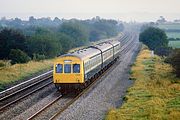 |
C822 (51495, 59096 & 51510) passes Badgeworth on the misty morning of 12 October 1985 with the 07:32 Birmingham New Street to Gloucester service. This was nearly a decade before the Grovefield Way bridge was constructed over the railway, just beyond the signal in the background. |
|
 |
822 (51495, 59096, & 51510) passes Little Haresfield (near Gloucester) with the 10:30 Cheltenham to Swindon service on 24 April 1986. The blotchy yellow on the front end is not the fault of the early Fujichrome slide (sometimes noted for bizarre colour), but is the result of some inexpert touching up of the paintwork. 822 was split up in 1988 and withdrawn shortly afterwards. 51495 and 59096 were cut up at Mayer Newman, Snailwell, and 51510 ended its days at Vic Berry's, Leicester. |
|
 |
A historic 1980s view of Kingham station, from a viewpoint that is no longer possible due to the rapid growth of those innocuous looking ash tree 'bushes' in the foreground. Also, trees on the other platform now virtually screen off the old Banbury and Cheltenham line platforms, that can clearly be seen here. C823 (51505, 59082 & 51511) calls with the late running 2A81 16:00 Worcester Shrub Hill to Oxford on 16 October 1983. Class 101s were far less common on the Cotswold Line than Class 117s & 119s, although this particular unit did put in numerous appearances. |
|
 |
C823 (51505, 59082 & 51511) passes Purton on 20 July 1985 with the 2B24 10:45 Swindon to Gloucester service. This photo is taken from the footpath crossing that links New Road on the north side of the line, with Witts Lane on the south side. |
|
 |
Mid June is not really the ideal time to be taking pictures in the 'Golden Valley' between Sapperton and Stroud, as it doesn't really live up to its name! C823 (51505, 59082 & 51511) has just crossed Frampton Mansell Viaduct on 20 June 1987 with the 2B25 09:40 Swindon to Cheltenham Spa service. |
|
 |
Making a change from the more usual Class 117 unit, C823 (51505, 59082 & 51511) passes a rampant lineside buddleia bush and arrives at Charlbury station on 10 August 1987 with the 2A79 07:45 Moreton-in-Marsh to Oxford service. Unit, buddleia and foreground grass have all yielded to progress. The 101 has long since been replaced by Class 165 & 166 Turbo units, while the vegetation succumbed to platform and car park lengthening. |
|
 |
825 (53165, 59118 & 53164) heads north from Torre on 23 November 1991 with the 10:12 Paignton to Exmouth service. Note that this set contains two DMBS vehicles. I couldn't resist this going away shot, due to the excellent autumnal lighting. |
|
 |
Looking smart with its freshly applied red buffer beam, L830 (53333, 59105 & 51190) passes the field of pigs, as it approaches Culham on 8 May 1988 with the 2C30 11:42 Didcot Parkway to Oxford Network SouthEast service. If it wasn't for the mist, Didcot Power Station would dominate the background of this view. |
|
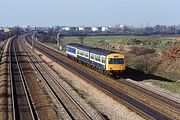 |
Two thirds of set L831 (53265 & 59115) & Class 121 'Bubble Car' 55030 (L130) approach Iver on 22 February 1990 with the 2A40 11:01 Maidenhead to Paddington Network SouthEast service. Although I have quite a few pictures of a Class 121 replacing the DMBS vehicle of a Class 117 set, I have far fewer pictures of this 121/101 combination. |
|
 |
L832 (51226, 59570 & 51499) passes non-stop through Sunnymeads station on 10 December 1989 with the 14:33 Staines to Windsor & Eton Riverside service. As can be guessed by the third rail, the line's normal motive power is 750V DC EMUs. The Network SouthEast DMU was taking part in the Windsor & Eton Gala Day, and whilst not as noteworthy as 50007 Sir Edward Elgar or Metropolitan Railway Bo-Bo No.12 Sarah Siddons, which were also taking part in the event, it was still just as much an unusual visitor. Unfortunately the weather was uniformly grim all day. |
|
 |
L832 (51499, 59570 & 51226) nears journey's end as it passes on 21 September 1991 with the 15:35 Reading to Gatwick Airport Network SouthEast service. This unit survives (albeit minus its centre car, which was cut up at MC Metals, Glasgow in 1993), and can now be seen at the Mid Norfolk Railway. |
|
 |
The Mid Norfolk Railway's resident 101 twin set (51226 & 51499) passes Dereham signal box, after a brief visit to the yard on 29 May 2014. As indicated by the destination blind, the unit would shortly be working the 12:45 service to Wymondham Abbey. Despite appearances (red lights) the unit is actually moving forwards! |
|
 |
The Mid Norfolk Railway's resident 101 twin set (51226 & 51499) stands at Wymondham Abbey station on 29 May 2014, having just arrived with the 12:45 service from Dereham. This is the line's southern terminus, although the line continues on to form a connection with the national network. |
|
 |
L835 (51498, 59530 & 51432) stands at Oxford station's platform 1 on 21 October 1988, after having just arrived with the 2C45 14:45 Banbury to Oxford Network SouthEast service. This view clearly shows the result of the half hearted attempt to modernise the station in the early 1970s. The new canopy above the DMU backed onto a very poor prefabricated structure that was hardly any better than the wooden building it replaced. As you can see, this modernisation only extended half way down the platform, so that after a bizarre gap, a section of the original GWR canopy can be seen in the background. |
|
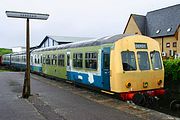 |
L836 (51434, 59117 & 51503) in the early stages of rubbing down at Dereham, on the Mid Norfolk Railway on 29 May 2014. This unit was withdrawn from mainline service in 1996, becoming the first of its class to enter preservation. It is also one of the few 3 car Class 101 sets in preservation. |
|
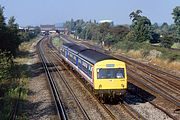 |
L838 (53331, 59125 & 53308 ) heads south at Horley on 21 September 1991 with the 13:35 Reading to Gatwick Airport Network SouthEast service. This was one of the hourly trains that traversed the North Downs Line. |
|
 |
Weary commuters trudge through the drizzle at Bedwyn station on 3 July 1992, after just getting off the 2K30 17:41 Reading to Bedwyn Network SouthEast service, on this occasion worked by L840 (53311, 59117 & 53322). The infant River Dun can be seen meandering through the field behind the station, with the Kennet & Avon Canal in the background. |
|
 |
L840 (53322, 59117 & 53311) emerges from the turnback siding, and approaches Bedwyn station on 3 July 1992, ready to form the 2K73 18:48 Network SouthEast service to Reading. It had arrived a few minutes earlier as the 2K30 17:41 train from Reading. Although the rain had just started to clear, it doesn't seem like the ideal day to be hanging out the washing! |
|
 |
With the spire of St Paul's church dominating the background, L840 (53322, 59117 & 53311) pulls away from Wokingham station on 17 July 1993 with the 18:50 Reading to Gatwick Network SouthEast service. Unfortunately I have few pictures taken on this route, which has had an interesting variety of traction over the years, starting with the Class 206 'Tadpole' DEMUs, which took over from steam in 1965. Class 119s replaced the thumpers in 1980 and were gradually replaced by Class 101s during the late 1980s. Heritage traction finally gave way to Class 165 'Turbos' shortly after this picture was taken. |
|
 |
Network SouthEast in the Peak District! With its inappropriate livery, and obsolete London set number, L840 (53322 & 53311) approaches Bamford on 10 March 1997 with the 12:47 Manchester Piccadilly to Sheffield service. The bridge in the background carries the line over the River Derwent. |
|
 |
L841 (53332, 59091 & 53312) calls at Heyford station on 24 May 1990 with the 2C65 18:44 Banbury to Oxford Network SouthEast service. This unit survived for another three years in three car form, then minus 59091 for a further three years, before the inevitable call to MC Metals at Glasgow. |
|
 |
L841 (53312, 59091 & 53332) accelerates away from Goring on 28 August 1991 with the 2C56 16:30 Reading to Oxford Network SouthEast service. This picture was taken from a bridge that provides access to a few riverside houses. There was once a ferry across the Thames nearby, although there was nothing on the other side of the river, apart from fields! |
|
 |
L841 (53332, 59091 & 53312) pulls away from Pangbourne station on 28 April 1993 with the 2C48 15:30 Reading to Banbury Network SouthEast service. Pangbourne's goods shed and small goods yard formerly occupied the strip of land directly behind the DMU. |
|
 |
Network SouthEast liveried L841 (53332 & 53312) is a long way from its former home as it passes the site of Agecroft Junction (near Salford) with the 07:31 Buxton to Soutport service on 10 June 1994 in the company of a more appropriately liveried Regional Railways Class 101 unit. L841 had been ousted from its Thames Valley workings by the introduction of Class 165 Turbo units a couple of years previously. In the mass shuffling of heritage units in the mid 1990s the repainting into new colour schemes took a low priority on what was considered to be stop gap traction. |
|
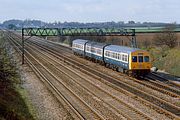 |
L842 (53327, 59101 & 53314) passes Waltham St Lawrence on 5 March 1988 with the 2A36 11:54 Reading to Paddington Network SouthEast service. The centre coach is actually a Class 111 vehicle, but as the only difference between Met Cam's Class 111 and 101 was the use of Rolls Royce instead of AEC engines, and as the centre coach is a trailer vehicle, it is for all practical purposes, identical. |
|
 |
Langley oil depot is prominent in the background of this view of the Great Western Mainline at Iver, taken on 22 February 1990. L842 (53327, 59101 & 53314) runs along the up relief line with the 2A36 09:35 Reading to Paddington Network SouthEast service. |
|
 |
L842 (53327, 59101 & 53314) passes South Moreton on 6 May 1992 with the 2C68 18:01 Reading to Oxford Network SouthEast service. This train would normally only go as far as Didcot Parkway, and although destination blinds were often wrong, it seems in this case it was correct, as the ECS was half an hour late returning. The following year L842 would leave the Thames Valley, and head west to Cornwall, where its Network SouthEast livery would look slightly out of place as it worked trains on the Falmouth and St Ives branches! |
|
 |
Thames Valley Class 101 sunset. Shortly before being ousted by the new Class 165s, L842 (53314, 59101 & 53327) runs along the up main line at South Moreton on 6 May 1992 (as booked) with the 5C68 ECS to Reading. Normally this would start from Didcot Parkway at 18:46, after the unit had worked the 2C68 18:01 Reading to Didcot Parkway Network SouthEast service. However, on this occasion it seems that the train had been extended to Oxford, which explains why this was running half an hour late. |
|
 |
A bitterly cold day at Carbis Bay on 19 March 1994, and consequently the beach is virtually deserted. L842 (53327 & 53314) runs along the cliff edge with the 10:20 St Ives to St Erth service. The unit had been transferred from Reading to Laira the previous year, but in view of its limited remaining life, it did not receive a repaint from the now totally inappropriate Network SouthEast livery. |
|
 |
C851 (51462, 59382 & 51530) approaches the site of the former level crossing at Quedgeley on 6 May 1988 with the 2B03 07:35 Swindon to Cheltenham Spa service. This level crossing was closed in 1982, and replaced by an underbridge a little to the south. |
|
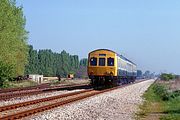 |
C851 (51530, 59382 & 51462) passes Quedgeley on 6 May 1988 with the 2A21 09:30 Cheltenham Spa to Swindon service. There area a couple of interesting points to note about this picture. Firstly, the driver has forgotten to change the marker lights at Cheltenham, with the result that the unit is displaying two red lights on the front, against all the regulations. Presumably it was also displaying a white light to the rear. Secondly, the Dowmac concrete sleeper works sidings can be seen in the background, with the company's Ruston & Hornsby shunter plainly in view. The works closed shortly after this picture was taken, and the site has now been cleared. |
|
 |
Hybrid Class 101/108 unit P870 (53200 & 53638) picks up at least one passenger, as it calls at Eggesford station on 1 August 1990 with the 11:15 Exmouth to Barnstaple service. After 53200 was withdrawn from passenger use in 1993, it had another life for a few years as part of the 960994 route learner / sandite set. |
|
 |
A charming rural scene at Newton St Cyres (now much overgrown), pictured on 1 August 1990. Hybrid Class 101/108 unit P870 (53200 & 53638) approaches the station with the 13:01 Barnstaple to Exeter Central service. The road in the background leads to Crediton. |
|
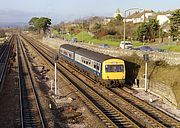 |
P872 (53247 & 53646) rattles past Aller with the 12:45 Exmouth to Paignton service on 7 December 1988. An interesting route for a local service, from one seaside resort to a another, requiring a reversal at Exeter St Davids. Laira's P872 was one of the many 'lash up' DMU sets formed in the late 1980s, in this case made up of two entirely different classes. While the lead vehicle here (53247) is a Metro Cammel Class 101, the second vehicle is a BR Class 108! In this form P872 had a comparatively short life, with 53247 being withdrawn in late 1990 and cut up at Meyer Newman at Snailwell, while 53646 soldiered on for a couple more years until eventually being scrapped at Gwent Demolition in May 1992. |
|
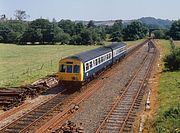 |
P874 (53330 & 53315) arrives at Lapford on 1 August 1990 with the 12:57 Exeter St Davids to Barnstaple service. The line on the right is the former passing loop, used latterly to service the UKF fertiliser depot, which ceased using rail around the time this picture was taken (the track certainly looks like nothing has ventured along it for some time). |
|
 |
876 (53189 & 51231) climbs Dauntsey Bank, and passes Tockenham Wick in the gloom on 14 March 1991 with the 2A09 07:38 Highbridge to Swindon service. Highbridge to Swindon seems an unlikely start and finish point for a train! |
|
 |
876 (51231 & 53189) climbs past Narroways Hill Junction, as it leaves Bristol on 16 May 1992 with the 18:34 Bristol Temple Meads to Gloucester service. The unit has just crossed over Glenfrome Road, which links Eastville on the east of the line, with Montpelier on the west. |
|
 |
With the 1883 built Stracey Arms Drainage Mill prominent in the background, 101653 (51426 & 54358) crosses the flat expanse of Halvergate Marshes with the 15:20 Great Yarmouth to Norwich Regional Railways service on 29 August 1992. 101653 managed to survive into the 21st Century, one of the few 'heritage' units (as they had by then become known!) to do so. At the time this picture was taken the unit was allocated to Cambridge depot, but like the other survivors of the class it migrated to the north west for its final years in traffic. |
|
 |
101654 (51800 & 54408 ) passes Yarmouth Vauxhall Signal Box, as it leaves Great Yarmouth station on 29 August 1992 with the 13:20 Regional Railways service to Norwich. It is a summer Saturday, and there is the inevitable tailback of traffic on the A149 road in the background, as everyone heads for the seaside! |
|
 |
101655 pulls away from Brundall station on 29 August 1992 with the 09:50 Norwich to Lowestoft Regional Railways service. Hardly ideal lighting, but it is the only picture I have of the archetypal East Anglian DMU at this classic location. |
|
 |
101656 (54056 & 51230) approaches Mobberley on 20 July 1996 with the 08:23 Chester to Manchester Piccadilly Regional Railways service. 101656 managed to hang into the new Millennium, being withdrawn in November 2001. Strangely, after having run around together for a number of years these two vehicles were sent their separated was for disposal. 54056 being cut up in Rotherham, and 51230 meeting its end in Caerwent. |
|
 |
An impressively clean looking 101658 leaves Reedham station on 29 August 1992 with the 11:50 Norwich to Lowestoft Regional Railways service. Already over 30 years old when this picture was taken, the Metro Cammell units would be in service for another decade, with the majority in this blue and white Regional Railways livery. |
|
 |
101677 is dwarfed by the surroundings, as it leaves Chinley station on 12 March 1998 with the 09:15 Sheffield to Manchester Piccadilly service. I can't remember now whether anybody got on, but clearly nobody got off! |
|
 |
101677 passes Edale on 28 March 1999 with the 11:55 Manchester Piccadilly to Sheffield service. The bridge is one of a number on this stretch of line giving farmers access to the fields on the southern slopes of Kinder Scout. |
|
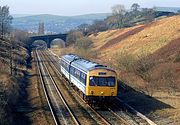 |
101678 approaches Chinley on 10 March 1997 with the 10:47 Manchester Piccadilly to Sheffield service. Over the years this location had seen a wide variety of DMU classes, but by this time the venerable Met Cams were the main representative of the original fleet, and would soldier on for another six years. |
|
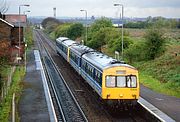 |
The Metro Cammell Class 101s worked their final services on the national network around the Manchester area, with the last units being withdrawn in 2003. Two of the last surviving twin car sets, 101678 & 101662 are seen here a few years earlier at Lostock Gralam. They are working the 08:23 Chester to Manchester Piccadilly on 4 April 1998. |
|
 |
101678 approaches Great Crakehall on the Wensleydale Railway with the 13:30 Leyburn to Leeming Bar service on 14 May 2005. As can be seen from the different bodyside profile and door configuration, the centre vehicle is in fact a Class 117 vehicle (59509). 51210 is leading, with 53746 at the rear. This unit has subsequently been repainted into the railway's own colour scheme. |
|
 |
101678 (53746 & 51210, running with former Class 117 centre car 59509) emerges from the woods at Great Crakehall on the Wensleydale Railway with the 14:30 Leeming Bar to Redmire service on 14 May 2005. 101678 was one of the final 'heritage' DMU on the national network, finally being withdrawn in December 2003. It has since been repainted into a non authentic dark blue and cream Wensleydale Railway colour scheme, but is seen here in a rather faded Provincial Railways livery. |
|
 |
101682 and two unidentified classmates catch the very last rays of the setting sun as they pass Farington Junction with the 18:27 Blackpool North to Buxton North West Regional Railways service, even though it says Manchester in the destination blind. The date is 14 September 1996, and although the rest of the country was busily ridding itself of first generation DMUs at this time, the 101s would be rattling around on local services in the area for a further seven years. |
|
 |
Longsight allocated 101685 was repainted into original green livery in the 1990s (albeit with a yellow warning panel) and thereafter was a frequent visitor to the picturesque Blaenau Ffestiniog line. It is seen here approaching Dolwyddelan on 27 August 1994 with the 12:05 Blaenau Ffestiniog to Llandudno Regional Railways service. Already 38 years old when this picture was taken, the unit would amazingly remain in traffic for almost another decade. Note that the driver has forgotten to alter the destination blind! |
|
 |
Retro green liveried 101685 passes Penmaenmawr on 9 August 1995 with the 10:42 Llandudno to Holyhead service. The unit remained in service until the very end of Class101 operations in 2003, and then all three vehicles were subsequently preserved. |
|
 |
The weak early morning sun only just starts to burn through the mist as Tyseley set TS403 (50336, 59114 & 50303) approaches Wolvercote Junction on 27 March 1982 with the late running 07:15 Oxford to Great Malvern service. It had just worked in with the 05:15 Worcester Shrub Hill to Oxford train, arriving 20 minutes late, which presumably explains why a Midland 101 set is being used instead of the customary Western Class 117 or 119. Obviously a last minute replacement for a non available unit. Both these services were the first trains in their respective directions over the Cotswold Line at the time. 50336 was renumbered 53336 before eventually being withdrawn in May 1989, and almost immediately being cut up at Vic Berry's, Leicester. |
|
 |
Tyseley set TS403 (53303, 59114 & 53336) approaches Bearley on 14 August 1983 with the 10:15 Leamington Spa to Stratford-upon-Avon service, even if Walsall is creeping into the destination blind window! These trains ran non-stop on a Sunday, depriving the diminutive station at Bearley of a service. The Stratford-upon-Avon to Henley-in-Arden road passes under the bridge by the rear of the unit. In addition to being the opposite way round from when I photographed this unit the previous year at Wolvercote Junction, it has also had the two driving cars remembered, 50303 to 53303 and 50336 to 53336. |
|
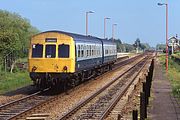 |
51187 & 54332 call at Whittlesea's staggered platform on 20 May 1991 with the 13:32 Peterborough to Cambridge Regional Railways service. In the steam era, the area around the station was surrounded by a large area of sidings, serving nearby brick works. |
|
 |
51188 seems to have received some strange front end damage (it looks rather like a shotgun was involved!). It is seen here leading the 11:04 Hunt's Cross to Manchester Oxford Road service past Glazebrook on 2 September 1987. Not much accuracy with the destination blind, as it is mis-wound halfway between Manchester Victoria and Llandudno Junction! |
|
 |
51218 & 54399 pass Eccles Heath in the rain on 16 April 1988 with the 11:52 Norwich to Ely service. The dwarf telegraph poles are presumably a legacy of the nearby Snetterton airfield, the presence of which could easily be heard on this occasion, as it is now a motor racing circuit. |
|
 |
Norwich Crown Point's set 59 (51442 & 54073) approaches Whittlesea station with the 13:50 Cambridge to Peterborough service on 20 May 1991. By this date the majority of passenger trains in East Anglia were operated by Sprinters, with only purely local stopping services such as this continuing to use heritage traction. The signal box in the background has subsequently been repainted into a rather odd mustard and green colour scheme. |
|
 |
The unusual sight of a Strathclyde PTE orange and black liveried Class 101 in Shropshire. 53146 & 51249 pass Madeley Junction Signal Box on 6 May 1991 with the 09:41 Pwllheli to Birmingham New Street service. The former Scottish unit had moved south of the border the previous year, becoming Tyseley's set T078. With only a limited life left, it retained the distinctive livery, just with the words 'Strathclyde Transport' painted out. |
|
 |
Norwich Crown Point depot's set 100 (53181, 59095 & 51508) passes Black Bank (between Ely and March) on 20 May 1991 with the 16:20 Ipswich to Peterborough service. Note the aerial on the front, which indicates that this unit can be used on the East Suffolk line, which is equipped with RETB signaling. |
|
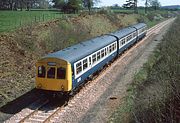 |
In the 1980s, Cotswold Line local services were usually worked by Pressed Steel Class 117 DMUs, with occasional appearances by the Birmingham Railway Carriage & Wagon Company Class 118s, Gloucester Railway Carriage & Wagon Company Class 119s, or the Metro Cammell Class 101s. In virtually all cases these were Western Region allocated sets, but here we see a Midland Region Class 101 set, complete with West Midlands branding, passing Cornbury Park (near Charlbury) on 26 April 1984. 53324 is leading the 2C74 14:15 Oxford to Hereford service. |
|
 |
54340 leads a lengthy DMU formation at speed (well, 75mph!) past the Great Northern Railway somersault signal (long since removed) at Havenhouse on 14 June 1986. It is working the 12:40 Skegness to Derby Saturdays only service, which was a real express service, stopping only at Boston and Nottingham. 54340 was withdrawn in April 1991 and cut up almost immediately. |
|
 |
54365 & 51175 pass Sleaford West Junction on 24 August 1991 with the late running 10:11 Nottingham to Skegness service. These two vehicles only spent a very short time as Cambridge Depot's set 61, before being split up and migrating into set 101661 (54365) & 101658 (51175), both of which then received Regional Railways livery. Although only allocated to Cambridge for a short time, the depot have added their CA sticker to the centre windscreen, just above the set number. |
|
 |
54388 & 51208 pass Wennington (New England Bridge) on 12 December 1985 with the 12:53 Peterborough to Hitchin service. Work had just started on the electfrication of the East Coat Mainline, but posts had only so far been erected on the west side of the line. I expect the hillside in the distance was an excellent spot to watch Deltics thrashing round the reverse curves near Wood Walton in the 1970s. |
|
 |
The North Norfolk Railway's green liveried Class 101 twin set (56062 & 51228) is pictured at Weybourne from a passing train on 30 May 2014. 56062 was one of the last heritage DMUs to be withdrawn, in 2002, less than a year before the removal of all vintage DMUs (certain Class 121 excepted!) from the national network. |
|
 |
The unmistakable crooked spire of Chesterfield church immediately identifies this location. On a very dull 18 February 1995, Research & Development unit 901002 Lab 19 Iris 2 (977693 & 977694) heads north, passing the local second hand car dealer's yard. This unit was converted from Class 101 vehicles 50222 & 50338 in 1991. The rather drab grey livery was its first colour scheme, it was later followed by the much more colourful Serco red and grey, Railtrack Blue and lime green, and ultimately Network Rail all over yellow. It entered preservation in 2008, ending up in the much more conventional green livery. |